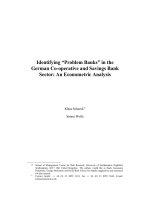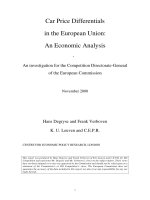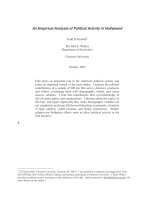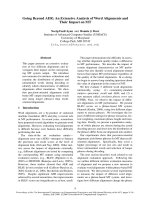VoIP- An In-Depth Analysis
Bạn đang xem bản rút gọn của tài liệu. Xem và tải ngay bản đầy đủ của tài liệu tại đây (361.29 KB, 16 trang )
Chapter 8. VoIP: An In-Depth Analysis
To create a proper network design, it is important to know all the caveats and inner workings of networking
technology. This chapter explains many of the issues facing Voice over IP (VoIP) and ways in which Cisco
addresses these issues.
Standard time-division multiplexing (TDM) has its own set of problems, which are covered in Chapter 1,
"Overview of the PSTN and Comparisons to Voice over IP," and Chapter 2, "Enterprise Telephony
Today." VoIP technology has many similar issues and a whole batch of additional ones. This chapter details
these various issues and explains how they can affect packet networks.
The following issues are covered in this chapter:
• Delay/latency
• Jitter
• Digital sampling
• Voice compression
• Echo
• Packet loss
• Voice activity detection
• Digital-to-analog conversion
• Tandem encoding
• Transport protocols
• Dial-plan design
Delay/Latency
VoIP delay or latency is characterized as the amount of time it takes for speech to exit the speaker's mouth
and reach the listener's ear.
Three types of delay are inherent in today's telephony networks: propagation delay, serialization delay, and
handling delay. Propagation delay is caused by the speed of light in fiber or copper-based networks. Handling
delay—also called processing delay—defines many different causes of delay (actual packetization,
compression, and packet switching) and is caused by devices that forward the frame through the network.
Serialization delay is the amount of time it takes to actually place a bit or byte onto an interface. Serialization
delay is not covered in depth in this book because its influence on delay is relatively minimal.
Propagation Delay
Light travels through a vacuum at a speed of 186,000 miles per second, and electrons travel through copper or
fiber at approximately 125,000 miles per second. A fiber network stretching halfway around the world (13,000
miles) induces a one-way delay of about 70 milliseconds (70 ms). Although this delay is almost imperceptible
to the human ear, propagation delays in conjunction with handling delays can cause noticeable speech
degradation.
Handling Delay
As mentioned previously, devices that forward the frame through the network cause handling delay. Handling
delays can impact traditional phone networks, but these delays are a larger issue in packetized environments.
The following paragraphs discuss the different handling delays and how they affect voice quality.
In the Cisco IOS VoIP product, the Digital Signal Processor (DSP) generates a speech sample every 10 ms
when using G.729. Two of these speech samples (both with 10 ms of delay) are then placed within one
packet. The packet delay is, therefore, 20 ms. An initial look-ahead of 5 ms occurs when using G.729, giving
an initial delay of 25 ms for the first speech frame.
120
Vendors can decide how many speech samples they want to send in one packet. Because G.729 uses 10 ms
speech samples, each increase in samples per frame raises the delay by 10 ms. In fact, Cisco IOS enables
users to choose how many samples to put into each frame.
Cisco gave DSP much of the responsibility for framing and forming packets to keep router overhead low. The
Real-Time Transport Protocol (RTP) header, for example, is placed on the frame in the DSP instead of giving
the router that task.
Queuing Delay
A packet-based network experiences delay for other reasons. Two of these are the time necessary to move
the actual packet to the output queue (packet switching) and queuing delay.
When packets are held in a queue because of congestion on an outbound interface, the result is queuing
delay. Queuing delay occurs when more packets are sent out than the interface can handle at a given interval.
Cisco IOS software is good at moving and determining the destination of a packet. Other packet-based
solutions, including PC-based solutions, are not as good at determining packet destination and moving the
actual packet to the output queue.
The actual queuing delay of the output queue is another cause of delay. You should keep this factor to less
than 10 ms whenever you can by using whatever queuing methods are optimal for your network. This subject
is covered in greater detail in Chapter 9, "Quality of Service."
The International Telecommunication Union Telecommunication Standardization Sector (ITU-T) G.114
recommendation specifies that for good voice quality, no more than 150 ms of one-way, end-to-end delay
should occur, as shown in Figure 8-1
. With Cisco's VoIP implementation, two routers with minimal network
delay (back to back) use only about 60 ms of end-to-end delay. This leaves up to 90 ms of network delay to
move the IP packet from source to destination.
Figure 8-1. End-to-End Delay
As shown in Figure 8-1
, some forms of delay are longer, although accepted, because no other alternatives
exist. In satellite transmission, for example, it takes approximately 250 ms for a transmission to reach the
satellite, and another 250 ms for it to come back down to Earth. This results in a total delay of 500 ms.
Although the ITU-T recommendation notes that this is outside the acceptable range of voice quality, many
conversations occur every day over satellite links. As such, voice quality is often defined as what users will
accept and use.
In an unmanaged, congested network, queuing delay can add up to two seconds of delay (or result in the
packet being dropped). This lengthy period of delay is unacceptable in almost any voice network. Queuing
delay is only one component of end-to-end delay. Another way end-to-end delay is affected is through jitter.
Jitter
Simply stated, jitter is the variation of packet interarrival time. Jitter is one issue that exists only in packet-
based networks. While in a packet voice environment, the sender is expected to reliably transmit voice packets
at a regular interval (for example, send one frame every 20 ms). These voice packets can be delayed
throughout the packet network and not arrive at that same regular interval at the receiving station (for example,
121
they might not be received every 20 ms; see Figure 8-2). The difference between when the packet is
expected and when it is actually received is jitter.
Figure 8-2. Variation of Packet Arrival Time (Jitter)
In Figure 8-2
, you can see that the amount of time it takes for packets A and B to send and receive is equal
(D1=D2). Packet C encounters delay in the network, however, and is received after it is expected. This is why
a jitter buffer, which conceals interarrival packet delay variation, is necessary.
Note that jitter and total delay are not the same thing, although having plenty of jitter in a packet network can
increase the amount of total delay in the network. This is because the more jitter you have, the larger your jitter
buffer needs to be to compensate for the unpredictable nature of the packet network.
If your data network is engineered well and you take the proper precautions, jitter is usually not a major
problem and the jitter buffer does not significantly contribute to the total end-to-end delay.
RTP timestamps are used within Cisco IOS software to determine what level of jitter, if any, exists within the
network.
The jitter buffer found within Cisco IOS software is considered a dynamic queue. This queue can grow or
shrink exponentially depending on the interarrival time of the RTP packets.
Although many vendors choose to use static jitter buffers, Cisco found that a well-engineered dynamic jitter
buffer is the best mechanism to use for packet-based voice networks. Static jitter buffers force the jitter buffer
to be either too large or too small, thereby causing the audio quality to suffer, due to either lost packets or
excessive delay. Cisco's jitter buffer dynamically increases or decreases based upon the interarrival delay
variation of the last few packets.
Pulse Code Modulation
Although analog communication is ideal for human communication, analog transmission is neither robust nor
efficient at recovering from line noise. In the early telephony network, when analog transmission was passed
through amplifiers to boost the signal, not only was the voice boosted but the line noise was amplified, as well.
This line noise resulted in an often-unusable connection.
It is much easier for digital samples, which are comprised of 1 and 0 bits, to be separated from line noise.
Therefore, when analog signals are regenerated as digital samples, a clean sound is maintained. When the
benefits of this digital representation became evident, the telephony network migrated to pulse code
modulation (PCM).
What Is PCM?
As covered in Chapter 1, PCM converts analog sound into digital form by sampling the analog sound 8000
times per second and converting each sample into a numeric code. The Nyquist theorem states that if you
122
sample an analog signal at twice the rate of the highest frequency of interest, you can accurately reconstruct
that signal back into its analog form. Because most speech content is below 4000 Hz (4 kHz), a sampling rate
of 8000 times per second (125 ms between samples) is required.
A Sampling Example for Satellite Networks
Satellite networks have an inherent delay of around 500 ms. This includes 250 ms for the trip up to the
satellite, and another 250 ms for the trip back to Earth. In this type of network, packet loss is highly controlled
due to the expense of bandwidth. Also, if some type of voice application is already running through the
satellite, the users of this service are accustomed to a quality of voice that has excessive delays.
Cisco IOS, by default, sends two 10 ms G.729 speech frames in every packet. Although this is acceptable for
most applications, this might not be the best method for utilizing the expensive bandwidth on a satellite link.
The simple explanation for wasting bandwidth is that a header exists for every packet. The more speech
frames you put into a packet, the fewer headers you require.
If you take the satellite example and use four 10 ms G.729 speech frames per packet, you can cut by half the
number of headers you use. Table 8-1
clearly shows the difference between the various frames per packet.
With only a 20-byte increase in packet size (20 extra bytes equals two 10 ms G.729 samples), you carry twice
as much speech with the packet.
Table 8-1. Frames per Packet (G.729)
G.729 Samples per Frame IP/RTP/UDP Header Bandwidth Consumed Latency*
Default (two samples per frame) 40 bytes 24,000 bps 25 ms
Satellite (four samples per frame) 40 bytes 16,000 bps 45 ms
Low Latency (one sample per frame) 40 bytes 40,000 bps 15 ms
*Compression and packetization delay only
Voice Compression
Two basic variations of 64 Kbps PCM are commonly used: µ-law and a-law. The methods are similar in that
they both use logarithmic compression to achieve 12 to 13 bits of linear PCM quality in 8 bits, but they are
different in relatively minor compression details (µ-law has a slight advantage in low-level, signal-to-noise ratio
performance). Usage is historically along country and regional boundaries, with North America using µ-law and
Europe using a-law modulation. It is important to note that when making a long-distance call, any required µ-
law to a-law conversion is the responsibility of the µ-law country.
Another compression method used often is adaptive differential pulse code modulation (ADPCM). A commonly
used instance of ADPCM is ITU-T G.726, which encodes using 4-bit samples, giving a transmission rate of 32
Kbps. Unlike PCM, the 4 bits do not directly encode the amplitude of speech, but they do encode the
differences in amplitude, as well as the rate of change of that amplitude, employing some rudimentary linear
prediction.
PCM and ADPCM are examples of waveform codecs—compression techniques that exploit redundant
characteristics of the waveform itself. New compression techniques were developed over the past 10 to 15
years that further exploit knowledge of the source characteristics of speech generation. These techniques
employ signal processing procedures that compress speech by sending only simplified parametric information
about the original speech excitation and vocal tract shaping, requiring less bandwidth to transmit that
information.
These techniques can be grouped together generally as source codecs and include variations such as linear
predictive coding (LPC), code excited linear prediction compression (CELP), and multipulse, multilevel
quantization (MP-MLQ).
123
Voice Coding Standards
The ITU-T standardizes CELP, MP-MLQ PCM, and ADPCM coding schemes in its G-series recommendations.
The most popular voice coding standards for telephony and packet voice include:
• G.711—Describes the 64 Kbps PCM voice coding technique outlined earlier; G.711-encoded voice is
already in the correct format for digital voice delivery in the public phone network or through Private
Branch eXchanges (PBXs).
• G.726—Describes ADPCM coding at 40, 32, 24, and 16 Kbps; you also can interchange ADPCM
voice between packet voice and public phone or PBX networks, provided that the latter has ADPCM
capability.
• G.728—Describes a 16 Kbps low-delay variation of CELP voice compression.
• G.729—Describes CELP compression that enables voice to be coded into 8 Kbps streams; two
variations of this standard (G.729 and G.729 Annex A) differ largely in computational complexity, and
both generally provide speech quality as good as that of 32 Kbps ADPCM.
• G.723.1—Describes a compression technique that you can use to compress speech or other audio
signal components of multimedia service at a low bit rate, as part of the overall H.324 family of
standards. Two bit rates are associated with this coder: 5.3 and 6.3 Kbps. The higher bit rate is based
on MP-MLQ technology and provides greater quality. The lower bit rate is based on CELP, provides
good quality, and affords system designers with additional flexibility.
Mean Opinion Score
You can test voice quality in two ways: subjectively and objectively. Humans perform subjective voice testing,
whereas computers—which are less likely to be "fooled" by compression schemes that can "trick" the human
ear—perform objective voice testing.
Codecs are developed and tuned based on subjective measurements of voice quality. Standard objective
quality measurements, such as total harmonic distortion and signal-to-noise ratios, do not correlate well to a
human's perception of voice quality, which in the end is usually the goal of most voice compression
techniques.
A common subjective benchmark for quantifying the performance of the speech codec is the mean opinion
score (MOS). MOS tests are given to a group of listeners. Because voice quality and sound in general are
subjective to listeners, it is important to get a wide range of listeners and sample material when conducting a
MOS test. The listeners give each sample of speech material a rating of 1 (bad) to 5 (excellent). The scores
are then averaged to get the mean opinion score.
MOS testing also is used to compare how well a particular codec works under varying circumstances,
including differing background noise levels, multiple encodes and decodes, and so on. You can then use this
data to compare against other codecs.
MOS scoring for several ITU-T codecs is listed in Table 8-2
. This table shows the relationship between
several low-bit rate coders and standard PCM.
Table 8-2. ITU-T Codec MOS Scoring
Compression Method
Bit Rate
(Kbps)
Sample Size
(ms)
MOS
Score
G.711 PCM 64 0.125 4.1
G.726 ADPCM 32 0.125 3.85
G.728 Low Delay Code Excited Linear Predictive (LD-CELP) 15 0.625 3.61
G.729 Conjugate Structure Algebraic Code Excited Linear
Predictive (CS-ACELP)
8 10 3.92
G.729a CS-ACELP 8 10 3.7
G.723.1 MP-MLQ 6.3 30 3.9
G.723.1 ACELP 5.3 30 3.65
Source: Cisco Labs
124
Perceptual Speech Quality Measurement
Although MOS scoring is a subjective method of determining voice quality, it is not the only method for doing
so. The ITU-T put forth recommendation P.861, which covers ways you can objectively determine voice quality
using Perceptual Speech Quality Measurement (PSQM).
PSQM has many drawbacks when used with voice codecs (vocoders). One drawback is that what the
"machine" or PSQM hears is not what the human ear perceives. In layman's terms, a person can trick the
human ear into perceiving a higher-quality voice, but a computer cannot. Also, PSQM was developed to "hear"
impairments caused by compression and decompression and not packet loss or jitter.
Echo
Echo is an amusing phenomenon to experience while visiting the Grand Canyon, but echo on a phone
conversation can range from slightly annoying to unbearable, making conversation unintelligible.
Hearing your own voice in the receiver while you are talking is common and reassuring to the speaker.
Hearing your own voice in the receiver after a delay of more than about 25 ms, however, can cause
interruptions and can break the cadence in a conversation.
In a traditional toll network, echo is normally caused by a mismatch in impedance from the four-wire network
switch conversion to the two-wire local loop (as shown in Figure 8-3
). Echo, in the standard Public Switched
Telephone Network (PSTN), is regulated with echo cancellers and a tight control on impedance mismatches at
the common reflection points, as depicted in Figure 8-3
.
Figure 8-3. Echo Caused by Impedance Mismatch
Echo has two drawbacks: It can be loud, and it can be long. The louder and longer the echo, of course, the
more annoying the echo becomes.
Telephony networks in those parts of the world where analog voice is primarily used employ echo
suppressors, which remove echo by capping the impedance on a circuit. This is not the best mechanism to
use to remove echo and, in fact, causes other problems. You cannot use Integrated Services Digital Network
(ISDN) on a line that has an echo suppressor, for instance, because the echo suppressor cuts off the
frequency range that ISDN uses.
In today's packet-based networks, you can build echo cancellers into low-bit-rate codecs and operate them on
each DSP. In some manufacturers' implementations, echo cancellation is done in software; this practice
drastically reduces the benefits of echo cancellation. Cisco VoIP, however, does all its echo cancellation on its
DSP.
To understand how echo cancellers work, it is best to first understand where the echo comes from.
In this example, assume that user A is talking to user B. The speech of user A to user B is called G. When G
hits an impedance mismatch or other echo-causing environments, it bounces back to user A. User A can then
hear the delay several milliseconds after user A actually speaks.
125









